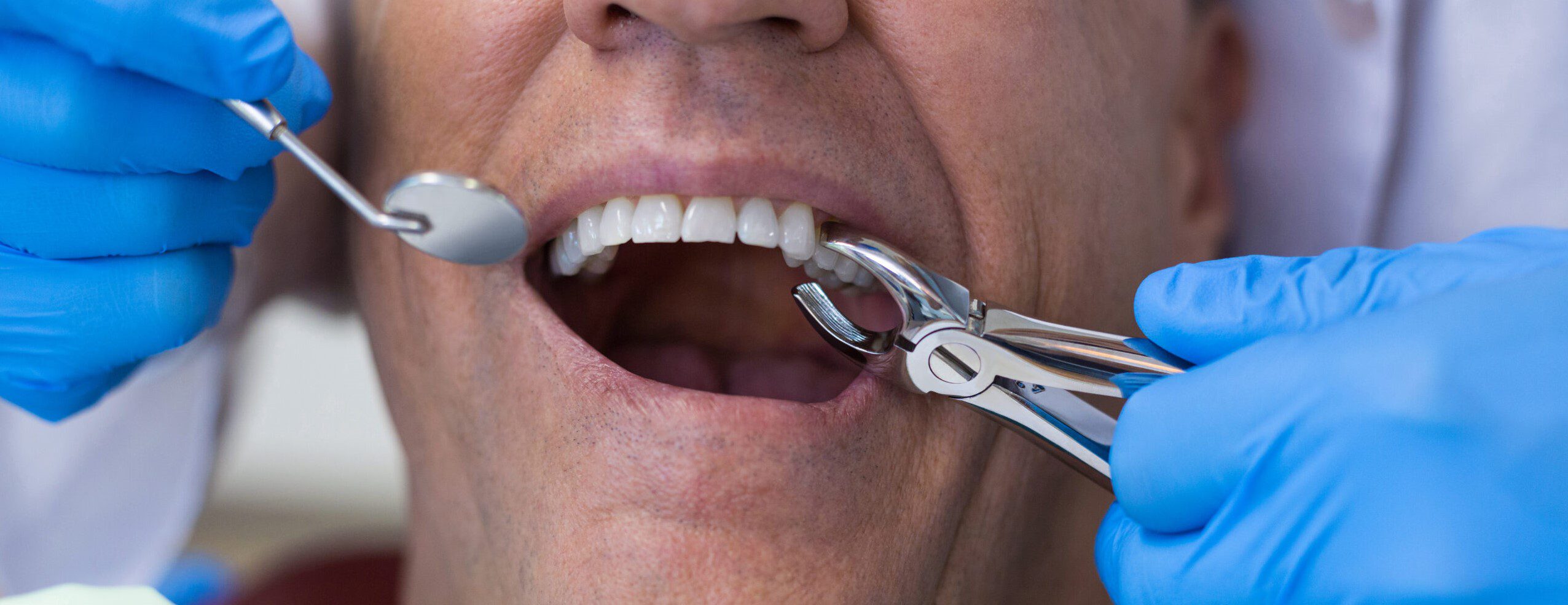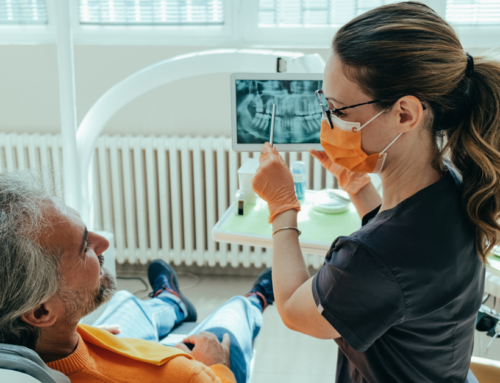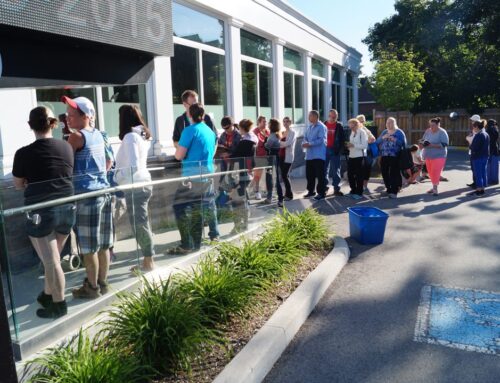Tooth Extractions – What To Expect When You Need To Have a Tooth Pulled
There are many reasons why someone may end up in a situation where a tooth must be extracted. However, regardless of the cause of the problem, the idea of having a tooth pulled can be very concerning for some patients. Here, we will address those concerns and clearly explain what patients in need of a tooth extraction can expect from the procedure, as well as what other actions may need to happen after the tooth is pulled.
Getting a tooth pulled is an unfortunate situation that nobody really wants to find themselves in. But, if your dentist tells you that it’s necessary to extract a tooth, you can be sure that it is in your best interests to get it done. Nevertheless, even though a tooth extraction is a very standard and common procedure, it’s not unusual for a patient in need of one to be more than a little apprehensive about the whole thing. After all, unless it’s a baby tooth that’s getting pulled, it’s not like it’ll just grow back. Have no fear though, because the entire process is quite simple, and there are multiple options available to help solve the problem of lost or missing teeth.
Why Would A Tooth Need To Be Pulled Out?
There are a wide range of reasons why someone may need to have a tooth pulled, and while some are completely out of our control, others are preventable. For example, one of the most common reasons why a tooth would need to be pulled is due to damage sustained from an accidental impact. A sudden strike from a hard object or the impact of a fall can often be enough to chip, crack, or break a tooth. Naturally, some accidents just can’t be prevented, but it may be possible to prevent some impacts such as those sustained during physically-intense sports.
Depending on the severity of the damage, the tooth may be able to be repaired with dental bonding to replace the missing tooth material, or it may be able to be restored using a dental crown. In the event that it cannot be effectively repaired, it will likely be necessary to remove the damaged tooth entirely. This helps illustrate why it is so important to take precautions when playing contact sports like hockey or football and wear a properly-fitted sports mouthguard.
Another reason for needing a tooth pulled is due to advanced tooth decay, a situation that is largely preventable. If cavities are left untreated, and if plaque and tartar continue to build up, the tooth will eventually decay to a state where it is not possible to repair and recover it. Teeth in this kind of condition run the risk of infection, which can be very serious if not treated appropriately. Proper dental hygiene habits and regular checkups with your dentist can help prevent this decay from occurring in the first place.
Sometimes, the need for a tooth extraction is entirely due to the lack of physical space in the patient’s mouth, such as is the case with many patients needing wisdom teeth extractions. Most people simply don’t have the room for wisdom teeth to grow in, and if they are not removed it can result in severe crowding, misalignment, bite pattern issues, speech impediments, and other long-term dental health issues.
As diverse as the reasons are as to why a tooth extraction may be necessary, the actual process of removing the tooth is fairly standard across the board. Of course, in some cases there could be some additional treatments that must occur before or after the extraction in order to obtain the best possible outcome. These include such things as dealing with any infections or existing conditions that could complicate the extraction procedure, or arranging for a post-procedure treatment to address other issues that may be identified.
Preparing For A Tooth Extraction
Before a tooth can be pulled, the dentist must first perform a thorough examination to determine the best course of action. This examination will begin with a physical inspection of the tooth and the surrounding areas of the mouth. This stage also usually includes a set of dental x-rays and imaging scans to get a comprehensive understanding of the state of the patient’s dental health and a clear view of the structural stability of the jawbone. This is particularly important in the case of tooth damage caused by accidental impacts, as there may be more trauma than what is visible on the surface that needs to be treated promptly.
The dentist will also review the available options for tooth replacement that can be done after the extraction, and discuss the various advantages of each. Tooth replacement options include dental bridges and dental implants, which we will provide more information on towards the end of this article.
Once the examination has been completed and a tooth extraction is determined to be necessary, the dentist will proceed according to the level of urgency. In some cases, another appointment will be scheduled to perform the extraction, usually within a few days to accommodate the schedules of both the patient and the dentist. However, in emergency situations where the risk of waiting would only cause more problems, the tooth may be extracted immediately following the examination.
In preparation for the extraction, patients are usually offered different levels of sedation to suit their comfort level. These options include, in order from lightest sedation to heaviest sedation; nitrous oxide (laughing gas), orally-administered sedatives in pill form, or IV sedation. The patient will also receive a local anesthetic to numb the tissues surrounding the tooth that will be extracted.
Does It Hurt To Get A Tooth Pulled?
Before we continue on with the process of tooth extraction, we suspect that many readers are wondering if it actually ‘hurts’ to get a tooth pulled. Fortunately, the combination of sedation and anesthetic helps ensure that you don’t feel a thing during the procedure. If you are unsure as to what level of sedation is right for you, reach out to your dentist and have a conversation about what options are available for you, and what you can expect from them.
How Are Tooth Extractions Performed?
With the anesthetic administered and the sedation in effect, the dentist will then perform the tooth extraction. Using specialized tools to firmly grip the tooth, the dentist will gradually manipulate the tooth in its socket to loosen it. Once the tooth has been sufficiently loosened, it will be lifted out of the socket. In some cases, the surrounding gum tissue may require small incisions to access the roots of the tooth and aid in its extraction.
Once the tooth has been removed, the incisions will be closed and the dentist will proceed with the next step of the process. Sometimes all that is required is to simply close the opening by connecting the surrounding soft tissues and allowing them to heal. However, in some cases there may be a need to graft a section of bone into the opening where the tooth was in order to reinforce the structure of the jaw and help strengthen the area. Another way the dentist may proceed after the extraction is to replace the missing tooth with an artificial tooth, thereby restoring the visual appearance of the patient’s smile avoiding any potential loss in mouth function.
What Happens After A Tooth Is Pulled?
After the procedure is complete, the patient will be monitored for a short time while the sedation wears off, at which time they will return home to recover. The local anesthetic will also subside, so pain relief and anti-inflammatory medication will likely be prescribed to make the patient more comfortable during the healing and recovery process. Most people experience mild swelling and soreness in the area of the extraction, which can effectively be managed with prescription medications or over-the-counter pain relievers.
Full recovery of the extraction spot usually takes a few weeks, but most people can return to regular daily activities within a couple of days. It’s important to take care of the area and keep it clean by swishing the mouth with an antibacterial mouthwash. It also helps to avoid chewing on that side of the mouth while it heals. It’s likely that your dentist will schedule a follow-up appointment at some point in the weeks after the tooth extraction to check on the healing and ensure things are progressing as expected.
Do Extracted Teeth Always Need To Be Replaced?
Some cases of tooth extractions do not require the replacement of the tooth, such as with the removal of wisdom teeth or the extraction of a baby tooth. However, in situations where a permanent tooth must be extracted due to advanced tooth decay or an accidental impact, it’s usually recommended that it be replaced with an artificial tooth. This is because the loss of a tooth can have a significant impact on the long-term dental health of a person, as well as on their general well-being.
Missing teeth are noticeable when a person smiles, and can also be apparent when talking, laughing, and eating. This can make some people feel much more self-conscious about their appearance, and sometimes even less likely to engage in social situations. There can also be functional effects from missing teeth. It can make chewing more difficult, restricting the types of foods some people are able to eat. In some situations it can also alter speech patterns, possibly in the form of lisps or slurring. Perhaps the most medically important concern related to missing teeth is the potential for gradual bone density loss.
As we move our mouths to perform tasks such as chewing or talking, the pressure exerted on the teeth stimulates the surrounding tissues and bones in the mouth, keeping them strong and resilient to stresses. When a tooth is no longer present in the jaw, the natural stimulation is lessened in that area, gradually leading to a weakening of the bone and gum tissues over time.
What Options Are Available To Replace A Lost Or Missing Tooth?
To prevent these long-term problems from developing, your dentist will recommend a treatment plan best suited to your particular case. Replacing a missing tooth is generally done in one of two ways, either with a dental bridge or a permanent dental implant.
Dental bridges are artificial teeth that are affixed on either side to the natural teeth that are adjacent to the gap created where the original tooth was extracted. Shaped and sculpted to mimic the appearance of the patient’s natural teeth, dental bridges are made from ultra-hard and durable materials such as ceramic, porcelain, or specially-formulated dental composites. They are an effective solution to the problem of missing teeth, and are visually indistinguishable from the other teeth in the mouth of the patient.
Dental implants are typically considered to be the preferred option for the replacement of lost teeth. Because they are embedded directly into the jaw bone, dental implants are able to replicate the natural pressure and stimulation exerted on the jaw by natural teeth. Dental implants do not rely on the adjacent teeth to support them, but rather are affixed into the bone material using a screw-like anchor. The anchor acts as an artificial root for the replacement tooth, atop of which sits a dental crown made to match the natural shape and shade of the patient’s other teeth. For all intents and purposes, a dental implant behaves just as a natural tooth does, fully restoring the appearance and function of the mouth after a tooth extraction.
For Emergency Tooth Extractions & To Maintain Good Dental Health, Contact Georgian Dental Today
Whether you’ve experienced an accident and need emergency care for a damaged tooth, or are in need of a tooth extraction for reasons such as tooth decay, wisdom teeth crowding, or other situation, the team here at Georgian Dental is ready to assist you. Addressing the potential problems associated with missing teeth promptly and with the right approach is crucial to obtaining the best possible outcome and keeping your mouth strong and healthy.
Contact us today to arrange for a no-obligation consultation and have all of your questions answered by our friendly dental professionals. We look forward to assisting you!
Appointment Request
If you’re interested in any of our procedures, and would like to meet with one of our dentists to discuss options, costs and get additional information, complete this short form and we’ll give you a call to arrange for a no-obligation appointment at our Barrie clinic.










